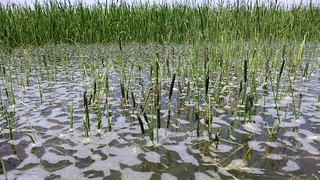Ark. crop value losses tallied at $35.6M; figure expected to rise after harvest
HEADS ABOVE WATER -- Flooding in rice in Philips County, Arkansas, forces hungry army worms to cling to rice to keep heads above water. Taken July 2, 2014. (U of Arkansas System Division of Agriculture photo by Robert Goodson)
August 29, 2014
Fast facts
- Flood damage to crops valued at $35.6 million
- Full extent of losses won’t be known until after harvest
- Yield data key to calculating total loss
- Soybeans hardest hit with $28.4 million in lost value
(683 words)
LITTLE ROCK – Flooding has caused $35.6 million in lost crop value, but the full extent of the damage won’t be known until after harvest, according to economists with the University of Arkansas System Division of Agriculture.
The study was conducted by Brad Watkins, and Archie Flanders, respectively professor and assistant professor of economics for the Division of Agriculture. It is based on information collected by county extension agents of the University of Arkansas System Division of Agriculture.
The two examined damage done by flooding that began in June in Craighead, Crittenden, Cross, Jackson, Lee, Monroe, Poinsett, Prairie, St. Francis, and Woodruff counties. In that 10-county area, floods affected 210,400 farm acres.
While the flooding this year was not as widespread as in 2011, “the timing of the floods this year occurred late enough that replant options were limited and highly risky,” said Mark Cochran, vice president-agriculture for the University of Arkansas and head of the U of A System Division of Agriculture.
By comparison, the 2011 flooding on the Mississippi and its tributaries cost Arkansas crop farmers $335 million in damage.
“This year’s damage can be categorized into four general classes: total loss with no replant; costs of replanting the same or alternate less profitable crop; yield losses and increased production costs due slowed crop development and late planting date; and prevented plantings,” Cochran said, adding that “while preliminary estimates are available from some damage, a more complete estimate will be possible only after harvest yields are available.”
Four types of loss
The study outlined four classes where value was lost:
- Total loss: $17.6 million. Some acreage was a total loss with crops completely destroyed and replanting not possible.
- Replanting costs: $18 million. Other acreage was damaged and replanted with the lost crop or another crop. Here, the value loss entails the cost of replanting and potential decreased yield due to a shortened growing season for the late-planted crop.
- Slowed development. In some acreage, floods slowed crop development. Losses due to diminished crop development won’t be known until harvest.
- Prevented planting. In some cases, flooding prompted growers to cancel planting plans for flooded acres. Data for prevented planted acreage will be available later this year.
Value loss by crop
Flanders and Watkins found that soybeans suffered the most, with losses pegged at $28.4 million. In other crops, value losses were:
- Rice - $5.6 million
- Corn and sorghum - $1.5 million
- Winter wheat - $0.1 million.
Value loss by county
Monroe, Poinsett, and Woodruff counties had the greatest value losses with each having more than $4.5 million in losses. They were followed by:
- Crittenden, Cross, Prairie, and St. Francis counties each with losses between $1.5 million and $4.5 million.
- Craighead, Jackson, and Lee counties each had losses of less than $1.5 million.
Effects into 2015
The effects of crop value losses will ripple into next year’s growing season, the economists said.
“Value losses in areas susceptible to flooding will negatively impact total farm profitability as commodity prices are decreased in 2014, and producers were already working with diminished profit margin potential,” said Flanders. “Value losses will have a negative impact on the producers’ ability to repay loans and meet long-term obligations.”
“With prices projected to remain low, losses due to flooding this year could impact the ability of producers to obtain operating loans for the 2015 production year,” he said.
Insurance
Watkins said that flood damage can also have ramifications on the likelihood of crop insurance indemnities being paid.
“Unlike drought, which can more uniformly affect an entire insurance unit -- the acreage covered by crop insurance for a specific crop -- flood damage is often more area-specific,” he said. “It is possible for a portion of the covered crop acreage to be lost to flood damage without any indemnity payments being triggered.
“For example, a producer could lose a field of a particular covered crop to flood, but the actual crop yield for the entire insurance unit inclusive of the flood-damaged field could still be high enough not to trigger a crop insurance indemnity,” Watkins said.
Summaries of the 2013 crop yield and other production information may be found here: www.nass.usda.gov/Quick_Stats/Ag_Overview/stateOverview.php?state=ARKANSAS.
The study may be found online:
- Crop Value Losses due to 2014 Flooding in East Central Arkansas: www.uaex.uada.edu/farm-ranch/economics-marketing/farm-planning/flooding-report-2014.pdf
- Economic Analysis of Crop Insurance Indemnities for Areas in Eastern Arkansas Affected by Summer Floods: http://www.uaex.uada.edu/farm-ranch/economics-marketing/farm-planning/flood-damage-analysis-2014.pdf
For more information about agricultural economics, visit http://uaex.uada.edu/farm-ranch/economics-marketing/default.aspx.
Pursuant to 7 CFR § 15.3, the University of Arkansas System Division of Agriculture offers all its Extension and Research programs and services (including employment) without regard to race, color, sex, national origin, religion, age, disability, marital or veteran status, genetic information, sexual preference, pregnancy or any other legally protected status, and is an equal opportunity institution.
By Mary Hightower
U of Arkansas System Division of Agriculture
Media Contact: Mary Hightower
Dir. of Communication Services
U of A Division of Agriculture
Cooperative Extension Service
(501) 671-2126
mhightower@uada.edu
Related Links
